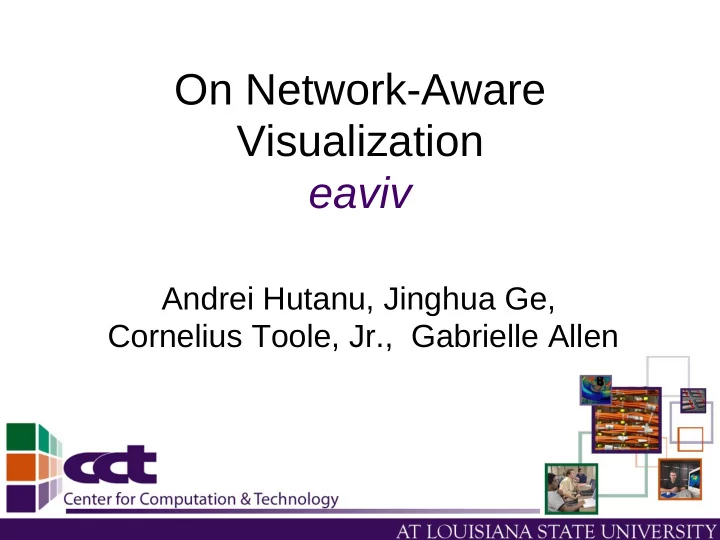

On Network-Aware Visualization eaviv Andrei Hutanu, Jinghua Ge, Cornelius Toole, Jr., Gabrielle Allen
Introduction • Data size increase – Instruments – Simulations • Emerging high-speed networks – Use to improve scalability of applications • CPU performance limited: use parallel and distributed resources, use GPU, storage resources • Create virtual meta-computer (OptIPuter)
Scenario
Improve Application • Additional motivation – Increase I/O rate (see movies) – Increase data size (top image: laptop only visualization, bottom image: distributed visualization on laptop using remote cluster) – Collaborative visualization capabilities
Goal • Visualization system requirements: – Interactive (5fps or more) – High data rate for I/O – Responsive (1-2 seconds at most between updates) – Handles large data (tens of gigabytes/volume, terabytes total data size) – High resolution (1 megapixel or more) – Good quality (no image artifacts, responsive to interaction) – Enables collaborative visualization
Motivation • Real datasets generated by scientists – Examples: Numerical Relativity (simulation of astrophysical systems) – 4096 3 /variable and timestep (tens of variables, hundreds of timesteps); Chemistry (x-ray tomography scan) – 32 Gigabytes/scan (2048 3 ); 24 datasets/experiment. • Want to have usable tools • Initially focusing on volume rendering
Visualization Pipeline • Visualization of remote data • Video streaming
eaviv Architecture
eaviv I/O - bandwidth • Networks faster than local storage • Distributed data servers • Use main memory to cache data • Fast protocols – Short-lived transfers (tens of seconds) – Reliable; Use on high-speed, possibly dedicated network links – TCP not suitable for high-speed links – Few usable alternatives, best is a protocol without congestion control (app sets rate)
eaviv I/O - latency • Blocking on I/O, serialized operations – Very expensive when doing remote I/O over high RTT links • Pipelined, non-blocking system – High operation throughput – Configurable operations (bulk, data formats)
Rendering • Parallel, GPU volume rendering, ray-casting • Only data sections. Progressive visualization
Interaction • Modify parameters (zoom, viewing direction) • Tangible devices: interfaces that enable direct manipulation of digital objects and actions through physical means – Support collaboration
Streaming • Images from remote renderer; collaboration • Avoid quality degradation using high-speed networks – High resolution – High frame rate – No compression (low latency) • Using SAGE – Parallel streaming from each node, UDP (though some issues when combined)
Results • Rendering performance; I/O speed; 8 node quad core Xeon, 4 Tesla S1070-16GB each • Video streaming requirements
Results
Results
Conclusions • Using networks to improve I/O speed • Remote rendering cluster to increase data size • Support for high quality collaboration • Future: increase data size, multiple clusters, multiple views
eaviv Project (300K, NSF EAGER) • Distributed visualization using dynamically configurable optical networks
Recommend
More recommend